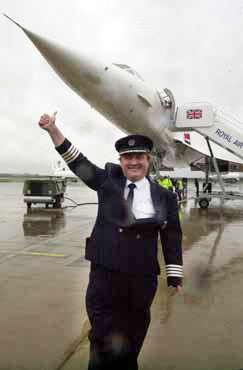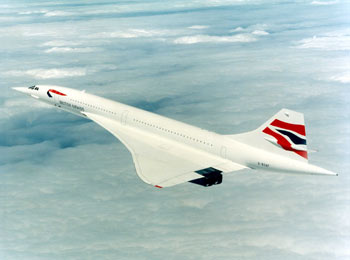|
At Mach2 it was quite literally ‘faster
than a speeding bullet’. It could carry 100 passengers in
style. So was Concorde the best plane that the aviation industry
has ever built? And just why is there no modern replacement?
by Stuart Carter
For the last 27 years,
Transatlantic passengers have routinely flown supersonically when
they climbed on board one of British Airways or Air France’s
Concorde’s. Its passengers were 80 percent business passengers
and included film stars, royalty, rock icons and sports legends.
Flying at more than twice the speed of sound they could travel form
London or Paris to New York in little more than 3 hours. Sadly,
now at the end of October 2003 the service is no more.
The invention of Concorde
ranks right up there alongside the Wright Flyer and Apollo 11. It
was a huge step forward in aviation. Just twenty years after the
sound barrier was first broken Concorde was designed and built to
carry 100 passengers at Mach 2 in comfort from one side of the Atlantic
to the other. At the time it was brave and visionary. And every
pilot who has flown it thinks it was great - from the cockpit 11
miles above the ground, that’s 55-60,000 feet high, they could
see the curvature of the Earth’s surface. Apart from spy planes
no one flew higher.
One of the greatest
achievements of the original design that engineers had to overcome
was the immense heat problems. At Mach2 the air is compressed so
much it heats the body of the plane. The front of the nose can reach
127 Celsius – well above boiling point even when the ambient
outside temperature is subzero. In fact it heated up so much that
overall it increased by 15 cms in length. When it’s at full
speed it feels hot if you touch the bare metal of the fuselage from
the inside. Without efficient air-conditioning the inside air temperature
would become unbearable and dangerous, higher than 100 Celsius!
Fortunately the fuel remains relatively cool inside the wings and
this can be circulated and used as a ’cooling’ fluid
to lower the air temperature inside the cabin. By the time a plane
arrives at New York the remaining fuel is much warmer than when
it took off in London.

Credit to Newscast
Captain
Mike Bannister - Chief Concorde Pilot from British Airways
after a successful flight
|
Concorde takes off
with the help of extra power from its after burners. This means
the jet exhaust gases are reheated with extra fuel to give 20% more
thrust – and unfortunately a lot more noise. Also the plane
is designed to cope with effects of the supersonic shock wave. As
the plane accelerates from Mach 1 to Mach 2 the shockwave pushes
the ‘lift’ on the upper surface of the wings further
back. To compensate for this, the centre of gravity has to be moved
otherwise the pane would end up nose-diving. Through a combination
of 33 fuels tanks and many pumps, one of the two on board engineers
shifts 12 tones of fuel toward the rear of the aircraft to counterbalance
the new ‘lift’ position. When the plane slows down at
the end of its journey fuel has to be pumped to the front again.
Amazingly now that
Concorde has finished its active service; there is no direct replacement.
In fact the Concorde fleet is still air worthy but the heavy costs
of running the service outstrip the revenue it can generate. And
it seems the same would be true even for more modern, efficient
supersonic aircraft. It is just far more efficient to fly much larger
numbers of people across the Atlantic sub sonically in 7 hours rather
than 3. When Concorde was first built, the French and British governments
swallowed the start up costs. R and D costs were in the tens of
billions of dollars, all of it paid for by the taxpayer. Originally
120 planes were planned but only the two airlines bought the planes
and costs skyrocketed even further. Finally only 2 prototypes and
14 planes were built. One of the limiting factors was that Concorde
could only travel supersonic over water. Overland the sonic boom
was too disruptive – it was a technical problem the engineers
could never overcome.
Concorde flies faster
than the speed of rotation of the earth. It’s like a time
machine. If the plane leaves London at 10.30 am it will arrive at
New York at 9.30am the same day.
Thousands have flown
on Concorde over the years. It is still one of the great machines
of all time and perhaps the greatest plane ever built. It is certainly
the only way the general public can travel faster than sound. Unfortunately,
they will never be able to do it again – probably not in my
lifetime at least. A trip to Australia from London takes 23 hours
with a single refuelling stop. If the same trip was done supersonically
it would take perhaps 12 hours, but there would still be need to
be at

Credit to Newscast
An Image
of Concorde in all her glory. When will we see her like
again?
|
least one stop. One thing is for sure,
in the future there will be more and more people wanting to travel
long distances at cost effective prices. Until someone designs a
supersonic plane that will be cheap to develop and cheap to run,
then supersonic long haul flights will be off limits.
Concorde was a product
of the post war, cold war era: a sort of child of the 60’s.
Like the space race, Concorde was a grand vision, a unique project
the likes of which we rarely see now. If the British and French
governments had continued to develop supersonic technologies then
today we might have an affordable mode of supersonic transport.
But now with over 3 decades of neglect the amount of Research and
Development that would be needed to build a new plane has pushed
any cost estimates sky high. It may take at least another 3 decades
before we see the likes of Concorde again. So perhaps Concorde will
remain the greatest plane ever built for many years to come?
|
